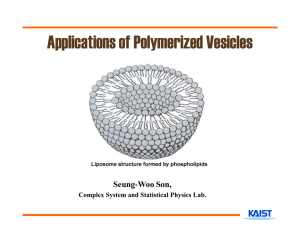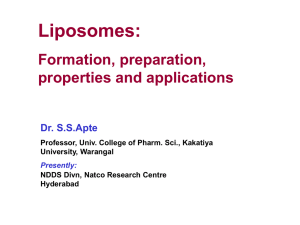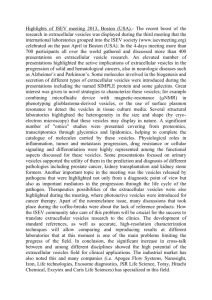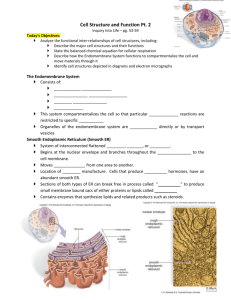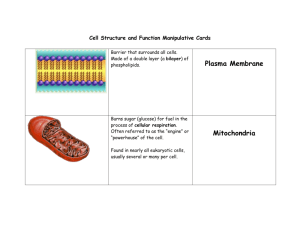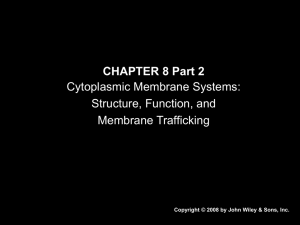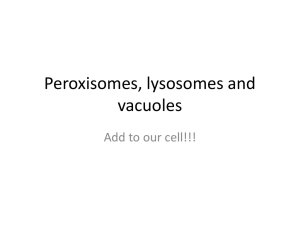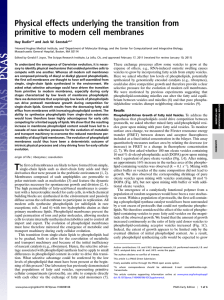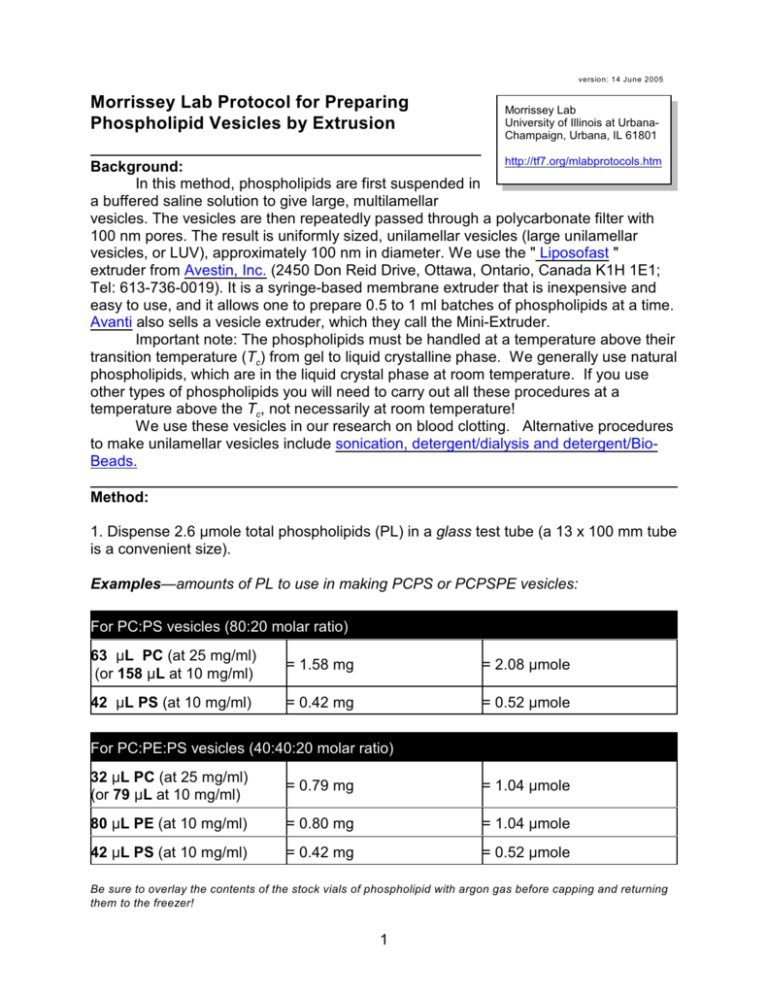
version: 14 June 2005
Morrissey Lab Protocol for Preparing
Phospholipid Vesicles by Extrusion
Morrissey Lab
University of Illinois at UrbanaChampaign, Urbana, IL 61801
http://tf7.org/mlabprotocols.htm
Background:
In this method, phospholipids are first suspended in
a buffered saline solution to give large, multilamellar
vesicles. The vesicles are then repeatedly passed through a polycarbonate filter with
100 nm pores. The result is uniformly sized, unilamellar vesicles (large unilamellar
vesicles, or LUV), approximately 100 nm in diameter. We use the " Liposofast "
extruder from Avestin, Inc. (2450 Don Reid Drive, Ottawa, Ontario, Canada K1H 1E1;
Tel: 613-736-0019). It is a syringe-based membrane extruder that is inexpensive and
easy to use, and it allows one to prepare 0.5 to 1 ml batches of phospholipids at a time.
Avanti also sells a vesicle extruder, which they call the Mini-Extruder.
Important note: The phospholipids must be handled at a temperature above their
transition temperature (Tc) from gel to liquid crystalline phase. We generally use natural
phospholipids, which are in the liquid crystal phase at room temperature. If you use
other types of phospholipids you will need to carry out all these procedures at a
temperature above the Tc, not necessarily at room temperature!
We use these vesicles in our research on blood clotting. Alternative procedures
to make unilamellar vesicles include sonication, detergent/dialysis and detergent/BioBeads.
Method:
1. Dispense 2.6 :mole total phospholipids (PL) in a glass test tube (a 13 x 100 mm tube
is a convenient size).
Examples—amounts of PL to use in making PCPS or PCPSPE vesicles:
For PC:PS vesicles (80:20 molar ratio)
63 :L PC (at 25 mg/ml)
(or 158 :L at 10 mg/ml)
= 1.58 mg
= 2.08 :mole
42 :L PS (at 10 mg/ml)
= 0.42 mg
= 0.52 :mole
For PC:PE:PS vesicles (40:40:20 molar ratio)
32 :L PC (at 25 mg/ml)
(or 79 :L at 10 mg/ml)
= 0.79 mg
= 1.04 :mole
80 :L PE (at 10 mg/ml)
= 0.80 mg
= 1.04 :mole
42 :L PS (at 10 mg/ml)
= 0.42 mg
= 0.52 :mole
Be sure to overlay the contents of the stock vials of phospholipid with argon gas before capping and returning
them to the freezer!
1
2. In the fume hood, dry the PL mixture under a gentle stream of nitrogen or argon.
When dry, speed-vac for an additional 1 hr to overnight under high vacuum. (This is to
remove any residual chloroform.)
3. To the dried-down PL, add 2.6 ml room temperature HBS solution and cover the end
of the tube with parafilm. Incubate 1 hr at room temperature with intermittent agitation.
4. Vortex tube vigorously to completely resuspend the PL. The result should be a milky,
uniform suspension. Freeze and thaw the suspension three to five times. (Freeze in dry
ice/alcohol bath; thaw rapidly at 37°C.)
5. Clean the Liposofast device with ethanol and dry it well. Assemble the device with
two membranes held between the two "O" rings and filter supports according to the
manufacturer's directions. (We generally use two polycarbonate membranes with 100
nm pore size, although other pore sizes can also be used.)
6. Load 0.5 ml of the lipid suspension into one of the two glass syringes and attach it to
the Luer lock on one side of the device. Close the other (empty) syringe and attach it to
the Luer lock on the opposite side of the device.
7. Press the loaded syringe to pass its entire contents through the filter and into the
opposing syringe. Repeat this process alternately with the two syringes for a total of at
least 11 passes. It is essential that you always use an odd number of passes, so that
the final product will end up in what was originally the empty syringe. This will ensure
that none of the starting multilamellar vesicles will contaminate the final product. In
addition, it is critical that this procedure be performed at a temperature that is above the
Tc for your lipid mixture.
8. Remove the final product and repeat steps 6 and 7 for the remaining, unprocessed
phospholipid suspension, until all of the suspension has been processed.
9. Store the final product at 4°C. The result is a uniform suspension of unilamellar
vesicles (about 100 nm in diameter) containing a total of 1 mM phospholipid in HBS.
Note:
You can confirm the final phospholipid concentration by assaying total phosphorus
content .
2
Materials and Solutions:
HBS (store at room temperature)
100 mM NaCl
20 mM Hepes/NaOH buffer, pH 7.5
0.02% (w/v) sodium azide
(50 mM Tris buffer, pH 7.5 may be substituted for the Hepes buffer)
Phospholipid Stock Solutions*
Phospholipid name
PC
PS
PE
concentration
L -alpha-Phosphatidylcholine,
L -alpha-Phosphatidylserine,
egg
10 or 25 mg/ml
bovine
liver-Na salt
L -alpha-Phosphatidylethanolamine,
bovine liver
MW
761
10 mg/ml
810
10 mg/ml
768
*We buy our phospholipids from Avanti Polar Lipids , dissolved in chloroform. The stock
solutions should be stored at -20°C under argon. Do not store more than 3 months (6
months for PC).
References
Mui B Chow L & Hope MJ (2003) Extrusion technique to generate liposomes of defined
size. Methods Enzymol 367:3-14.
http://www.avantilipids.com/extruder.html
http://www.avantilipids.com/ExtruderAssembly.html
http://www.avantilipids.com/LUVET.html
Copyright © 2005 James H. Morrissey. All rights reserved.
3

